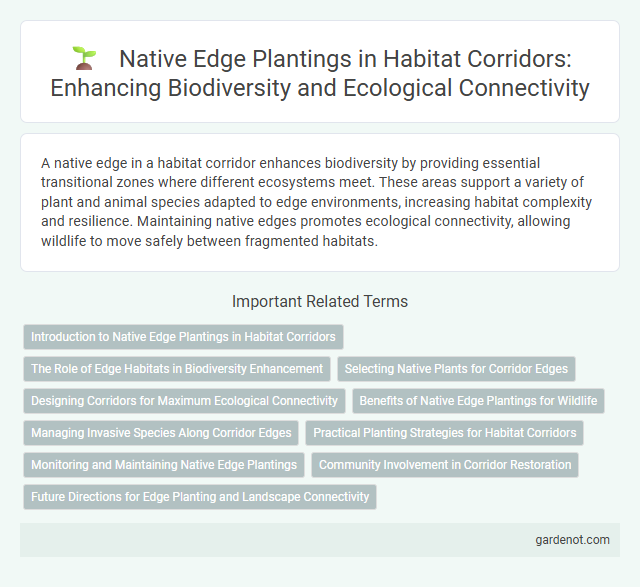A native edge in a habitat corridor enhances biodiversity by providing essential transitional zones where different ecosystems meet. These areas support a variety of plant and animal species adapted to edge environments, increasing habitat complexity and resilience. Maintaining native edges promotes ecological connectivity, allowing wildlife to move safely between fragmented habitats.
Introduction to Native Edge Plantings in Habitat Corridors
Native Edge plantings in habitat corridors play a crucial role in enhancing biodiversity by providing essential transitional zones between different ecosystems. These plantings support native wildlife by offering food sources, shelter, and migration pathways, promoting genetic diversity and ecosystem resilience. Incorporating species such as wildflowers, shrubs, and grasses native to the region ensures sustainable habitat connectivity and strengthens ecological networks.
The Role of Edge Habitats in Biodiversity Enhancement
Edge habitats in native ecosystems create unique microclimates and resource availability that support diverse species assemblages not found in core habitat areas. These transitional zones between different habitat types enhance biodiversity by providing critical nesting sites, food sources, and movement pathways for wildlife, increasing genetic flow and ecosystem resilience. Maintaining native edge habitats within habitat corridors is essential for promoting species richness and ecological connectivity across fragmented landscapes.
Selecting Native Plants for Corridor Edges
Selecting native plants for habitat corridor edges enhances biodiversity by providing essential food and shelter for local wildlife. Native species like goldenrod, milkweed, and chokecherry support pollinators and bird populations, promoting a balanced ecosystem. Incorporating diverse native vegetation also stabilizes soil and facilitates natural wildlife movement along the corridor edges.
Designing Corridors for Maximum Ecological Connectivity
Native edge plantings play a crucial role in designing habitat corridors by enhancing ecological connectivity and supporting native biodiversity. Strategically incorporating native edge vegetation helps stabilize microclimates, reduces invasive species intrusion, and provides critical resources for wildlife movement between fragmented habitats. Optimized corridor design leverages native edges to create continuous, resilient pathways that facilitate gene flow and species dispersal across landscapes.
Benefits of Native Edge Plantings for Wildlife
Native edge plantings enhance habitat corridors by providing essential food sources and shelter that support diverse wildlife populations. These plantings improve biodiversity by attracting pollinators, birds, and small mammals, creating vital ecological linkages between fragmented habitats. The structural complexity of native edges increases habitat quality, promoting species movement and genetic exchange across landscapes.
Managing Invasive Species Along Corridor Edges
Native edge vegetation plays a crucial role in managing invasive species along habitat corridor edges by creating a natural barrier that limits the spread of non-native plants. Effective monitoring and targeted removal of invasive species such as Japanese knotweed and kudzu help maintain biodiversity and ecosystem resilience. Incorporating native shrubs and grasses enhances soil stability and supports native wildlife, ensuring the corridor remains a functional passage for species migration.
Practical Planting Strategies for Habitat Corridors
Native edge planting enhances habitat corridors by using local plant species that support biodiversity and provide food, shelter, and nesting sites for wildlife. Practical strategies include selecting a diverse mix of native shrubs, grasses, and trees that adapt to local soil and climate conditions, improving corridor connectivity and resilience. Incorporating layered vegetation structures maximizes habitat complexity and benefits pollinators, birds, and small mammals essential for ecosystem health.
Monitoring and Maintaining Native Edge Plantings
Monitoring and maintaining native edge plantings ensures habitat corridors remain effective for wildlife movement and biodiversity preservation. Regular assessment of plant health, invasive species control, and soil quality supports the resilience of native vegetation along corridor edges. Implementing adaptive management strategies based on monitoring data optimizes the long-term ecological function of habitat corridors.
Community Involvement in Corridor Restoration
Native edge plays a crucial role in habitat corridor restoration by actively engaging local communities in planting native vegetation and monitoring wildlife. Community involvement enhances biodiversity by fostering stewardship, ensuring ongoing maintenance, and promoting environmental education. Collaborative efforts with Native edge significantly improve habitat connectivity and resilience within restored corridors.
Future Directions for Edge Planting and Landscape Connectivity
Future directions for native edge planting emphasize enhancing landscape connectivity by selecting indigenous species that support local biodiversity and ecosystem resilience. Integrating native edge vegetation can create continuous habitat corridors, facilitating wildlife movement and genetic exchange across fragmented landscapes. Advanced spatial planning and adaptive management strategies aim to optimize edge habitats for ecological function and climate adaptation.
Native edge, Infographic

 gardenot.com
gardenot.com